
The golden eagle is a bird of prey living in the Northern Hemisphere. It is the most widely distributed species of eagle. Like all eagles, it belongs to the family Accipitridae. They are one of the best-known birds of prey in the Northern Hemisphere. These birds are dark brown, with lighter golden-brown plumage on their napes. Immature eagles of this species typically have white on the tail and often have white markings on the wings. Golden eagles use their agility and speed combined with powerful feet and large, sharp talons to hunt a variety of prey, mainly hares, rabbits, and marmots and other ground squirrels. Golden eagles maintain home ranges or territories that may be as large as 200 km2 (77 sq mi). They build large nests in cliffs and other high places to which they may return for several breeding years. Most breeding activities take place in the spring; they are monogamous and may remain together for several years or possibly for life. Females lay up to four eggs, and then incubate them for six weeks. Typically, one or two young survive to fledge in about three months. These juvenile golden eagles usually attain full independence in the fall, after which they wander widely until establishing a territory for themselves in four to five years.

Euchloe ausonia, the eastern dappled white, is a southern European and Palearctic butterfly found mostly to the south and east of its almost indistinguishable relative the western dappled white.

Idaea muricata, the purple-bordered gold, is a moth of the family Geometridae. It was first described by Johann Siegfried Hufnagel in 1767 and is found in the Palearctic.

Aplocera praeformata, known as the purple treble-bar, is a species of moth in the family Geometridae.
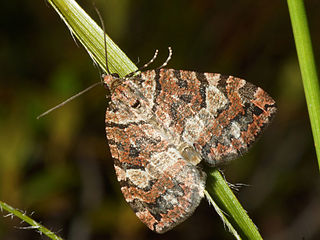
Hydriomena furcata, the July highflyer, is a moth of the family Geometridae. The species was first described by Carl Peter Thunberg in 1784. It is found in the Holarctic ecozone.

Lygephila lusoria is a moth of the family Erebidae. The species was first described by Carl Linnaeus in his 1758 10th edition of Systema Naturae. It is found in southern Europe, the Near East and Middle East, European south-eastern Russia, the Caucasus, Turkey and Israel.

Cucullia argentina is a moth of the family Noctuidae. It is found from central Turkey throughout the Caucasus, Iraq, Iran, Turkmenistan, southern Russia, Kazakhstan and Afghanistan to Mongolia.

Wallengrenia egeremet, the northern broken dash , is a butterfly of the family Hesperiidae. It is found in North America from southern Maine and southern Ontario, west across the Great Lakes states to southeastern North Dakota, south to central Florida, the Gulf Coast and south-eastern Texas.

Melanargia russiae, or Esper's marbled white, is a butterfly in the family Nymphalidae. It is found in Spain, Portugal, south-eastern France, Italy, the Balkans, southern Russia, the Caucasus and western Siberia.
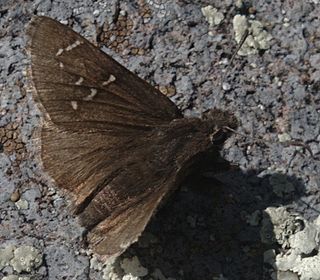
Thorybes mexicana, the Mexican cloudywing, mountain cloudy wing or Nevada cloudy wing, is a butterfly of the family Hesperiidae. It is found in the high elevation mountains of the western United States south into Mexico.
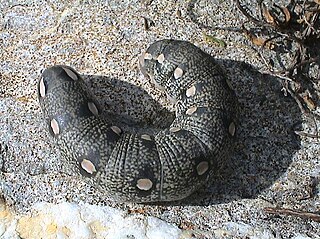
Hyles vespertilio is a moth of the family Sphingidae.

Sphingonaepiopsis gorgoniades, the Gorgon hawkmoth, is a moth of the family Sphingidae. The species was first described by Jacob Hübner in 1819. It is found from Croatia, Albania, Macedonia, central and southern Greece, eastern Bulgaria and Romania across southern Ukraine and the Crimea, southern Russia as far north as Kazan, the southern Urals and eastern Kazakhstan to Kyrgyzstan and Afghanistan. It has also been recorded from central and southern Turkey, Lebanon, Israel and western Jordan eastward across northern Iraq, the Caucasus, northern Iran to southern Turkmenistan.

Lithostege farinata is a moth of the family Geometridae. It is found from the Iberian Peninsula through north-eastern Germany east to eastern Europe and the Caucasus to western Siberia and Central Asia. In the north, it ranges to southern Scandinavia and the Baltic States. In the south, it is found up to southern Italy and the Balkan Peninsula. It has also been recorded from south-eastern Turkey and north-western Africa. There are old records from Israel and Egypt.
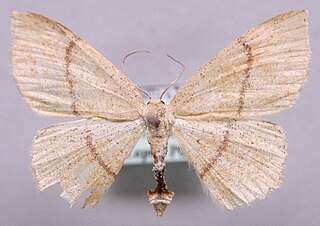
Cyclophora quercimontaria is a moth of the family Geometridae. It is found from southern Scandinavia to central and southern Europe and from western Russia to the Caucasus, northern Iran and the northern parts of Asia Minor.
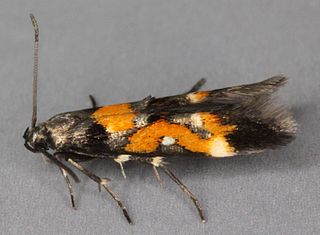
Mompha locupletella is a moth in the family Momphidae that can be found in the Palearctic including Europe.

Pungeleria capreolaria is a moth of the family Geometridae. It is found in the mountains of southern Europe, as well as on the Balkan Peninsula and the Caucasus.

Pediasia luteella is a species of moth in the family Crambidae. It was described by Michael Denis and Ignaz Schiffermüller in 1775. It is found in most of Europe. In the east, the range extends to Central Asia, the northern Caucasus, Transcaucasia, southern Siberia and Mongolia.
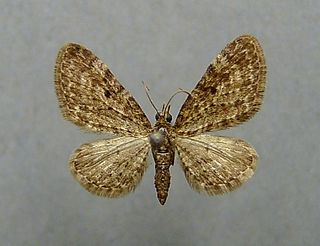
Eupithecia silenata is a moth of the family Geometridae. It is found in the mountainous areas of central and southern Europe, in the east, the range extends to the Krkonoše mountains and the Caucasus.

Eucrostes indigenata is a moth of the family Geometridae first described by Charles Joseph Devillers in 1789. It is found in the Mediterranean region, inland up to North Macedonia and Hungary. Subspecies lanjeronica is found in southern Spain and Algeria.

Eupithecia silenicolata is a moth in the family Geometridae. It is found from southern Europe and Morocco to western Asia, Iran and Pakistan. In the north, the range extends to southern Switzerland, Austria and northern Italy.




















